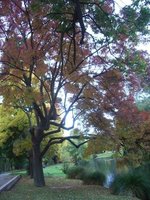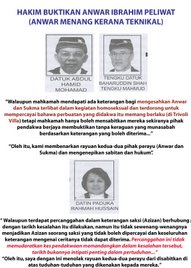 KUCHING, April 13 (Bernama) -- Datuk Seri Mohd Najib Tun Razak said Wednesday he is confident Barisan Nasional can win two-thirds majority in the Sarawak election on Saturday although the fight is tougher than it was in the previous polls.
KUCHING, April 13 (Bernama) -- Datuk Seri Mohd Najib Tun Razak said Wednesday he is confident Barisan Nasional can win two-thirds majority in the Sarawak election on Saturday although the fight is tougher than it was in the previous polls.The Prime Minister said that an earlier statement he made had not been reported in full by the alternative media which suggested that BN was worried that it could not achieve a two-thirds majority.
He said the alternative media had quoted him out of context, conveying a meaning other than what he intended.
"With this clarification, I hope there will be no doubt that I and the Sarawak Chief Minister (Tan Sri Abdul Taib Mahmud) have the same stand," he told TV3 and Bernama here.
The following is the clarification from the Prime Minister:
"I wish to stress that Barisan Nasional can achieve a two-thirds majority in this election although it is harder fought than the previous polls. Based on my observation and survey, the two-thirds majority can be obtained.
I had tried this morning to clarify that in a democracy, our intention is to form the government. This is the minimum objective, and I mentioned two-thirds majority as a bonus, but it is a bonus we can achieve.
But certain quarters have misinterpreted my statement to suggest that we were shaky and worried that two-thirds majority could not be achieved. This is not true."
tunku : BN must work harder to achieve the 2/3 majority.it is a tough battle ahead.judging by the mood, it is a sure 2/3 majority for BN but thing can change in the last minute.BN should adopt attack mode now.













 Malaysian Ringgit Converter
Malaysian Ringgit Converter
























1 comment:
The unique lifestyle and ambience of the localities of Sarawak today is a result from years of goodwill, understanding, cooperation and reciprocity among its indigenous groups with the Chinese.
A visit to the Chinese Museum in Kuching offers an interesting picture of Sarawak’s politics of development over the past 30 years that have risen from the Chinese connection. A tour of this Museum is recommended for all interested to learn and apply the secret of key business successes in order to extend it into the future successes of Sarawak.
The Chinese History Museum, located on the ground of the Kuching Waterfront within a stone throw of the landmark Tua Pek Kong Temple tells an interesting story to visitors to Kuching. According to history, the compact building housing the museum was originally built in 1912 as an administrative centre and the judicial court of the local Chinese, but was taken over by the Chinese Chamber of Commerce of Kuching in 1921 until the present Museum began in 1993.
For first time oversea visitors to Kuching, the museum showcases the multiplicity aspects of the dialectical make-up of Sarawak Chinese, thus providing a clearer perspective into the make-up of the Chinese psyche.
Inside the Chinese Museum, one can immerse in the history of the arrival of Chinese to Sarawak with old pictures and photographs of the bygone eras. All the dialect groups of the Sarawak Chinese are presented here, from the Hakka, Hokkien, Foochow, Cantonese to other minor groups. History buffs would enjoy soaking up the stories and exhibits while regaling in the success stories and vast contributions of the Chinese community leaders to Sarawak.
One can connect to the hardwork and vision of these early businessmen who applied their shrewd business acumen and understood the importance to develop goodwill and friendship by working closely with the local communities to benefit the Sarawakian economy.
Among the earliest indigenous groups to have contact with the outside world is the Melanau people. The community’s long history, legendary tales and myths add colour to the Mukah locality. Melanaus have produced many notable leaders, including Tan Sri Abdul Taib Mahmud, who led Sarawak in modern times as its Chief Minister.
Many have admired and asked how a Melanau, whose community make up only 6% of Sarawak’s population can rise up and more importantly, engineered Sarawak’s development. In this case, the close link between the Chinese with their local indigenous partnership should be celebrated. The Chinese connection and united ethnic groups led by their respective political parties riding on the politics of development concept have brought success to Sarawak in the past 30 years. Its proven historical success is seen as the master key to unlock another interesting phase in Sarawak’s exciting future.
Apart from ongoing infrastructural development like roads and town expansion, Sarawak is embarking on a massive transformation with The Sarawak Corridor of Renewable Energy or simply known as SCORE, a major initiative undertaken to develop the Central Region and transform Sarawak into a developed State by the year 2020. It aims to achieve the goals of accelerating the State's economic growth and development, as well as improving the quality of life for the people of Sarawak.
From now until 2016, the support and participation from the people of Sarawak are needed to build critical mass and momentum to trigger development, implement high priority infrastructure projects and manage high priority trigger projects. This presents a new shinning opportunity for the political leader possessing the mandatory experience and political savviness to rein in the close business cooperation of the myriad of Sarawak’s communities up to another level internationally.
By the act of harnessing on the Chinese communities and driven by the concept of politics of development, the world may read of another big success story from Sarawak.
Post a Comment